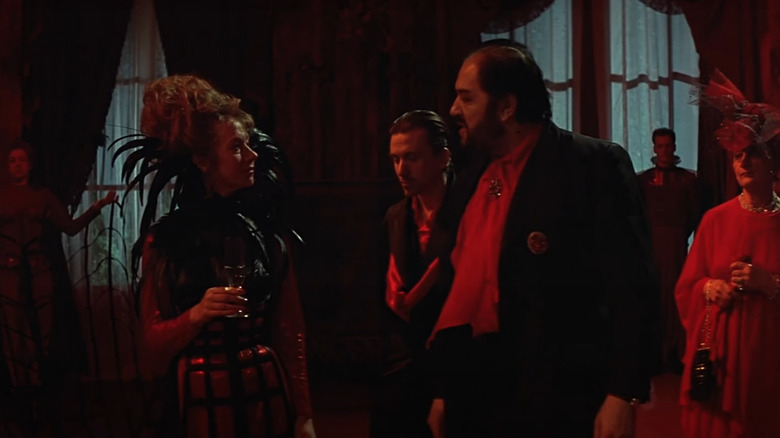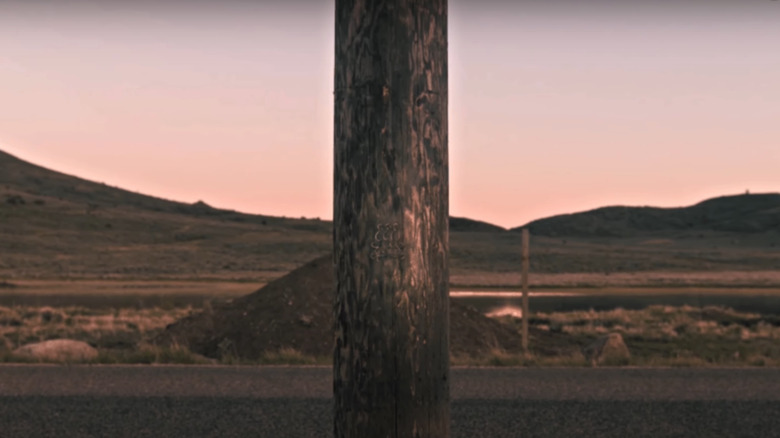The Unrated Movie That Ari Aster 'Regretted Watching' And Helped Inspire Hereditary
This post contains spoilers for "Hereditary" and "The Cook, the Thief, His Wife, and Her Lover."
Ari Aster became a big name in horror in 2018 with "Hereditary," but he'd had some practice at upsetting audiences by that point. All the way back in 2011, he caused a stir with his short film "The Strange Thing About The Johnsons," which focuses on a boy who sexually abuses his father over the course of his life. Aster said the film came from "an idea that sprouted between [him] and a few friends" about "taboos that weren't even taboos because they were so unfathomable." The short formed his thesis while studying at the American Film Institute's graduate school, and has since become infamous online as one of those films people claim they wish they never saw.
Aster brought that penchant for exploring deeply disturbing subject matter to "Hereditary," his first feature film (as well as its follow-up, "Midsommar"). Depicting the disintegration of a family besieged by a demon and his evil cult, "Hereditary" also deals with themes of loss and grief, and contains multiple scenes that, while they might not be as taboo as anything in "The Johnsons," have a tendency to linger in the mind just as much. That's a testament to the filmmaking talent that went into crafting "Hereditary," which so clearly draws stylistically from directors such as Nicolas Roeg and Stanley Kubrick.
Aster has often cited those filmmakers as big inspirations, especially Roeg, whose 1973 Giallo "Don't Look Now" shares a "spiritual" connection to "Hereditary," according to the director. But there's one movie that isn't mentioned as often in the discussion on Aster's influences — one that contains enough of its own unfathomable taboos that it was unrated upon its release.
Peter Greenaway's obscene elegance
Peter Greenaway is lesser known than Ari Aster, and even Nicolas Roeg, but is just as interesting a filmmaker. The British director started out as a painter before branching out into film and has since made dozens of movies, his most successful (and a great food movie) being 1989's "The Cook, the Thief, His Wife, and Her Lover."
The film follows brutish London gangster Spica (Michael Gambon), who buys a fancy French restaurant only to abuse the staff and patrons, eventually being murdered by his own wife (Helen Mirren). Throughout, Greenaway employs his painting expertise to create a vivid mise en scène for every frame, arranging characters as though they were elements of a renaissance painting and using shifting colors to represent emotional undertones — all captured expertly by cinematographer Sacha Vierny. Greenaway's frames are meticulously constructed tableaus, often explored by way of tracking shots that reveal symbols and visual clues as to what will happen as the film progresses.
However, the subject matter and content of "The Cook, the Thief, His Wife, and Her Lover" often doesn't match the elegance of Greenaway's painterly approach. The film includes everything from violence against women, child abuse, torture, and even cannibalism. As a result, Greenaway ran afoul of the MPA, which threatened to give it an "X" rating, before ultimately bestowing upon it the questionable "Unrated" label.
Given the graphic nature of the movie, it's not difficult to see why the MPA was concerned. But this wasn't some gross-out gore-fest — there was undeniable artistic merit to Greenaway's film. Even Roger Ebert admitted that while "The Cook, the Thief, His Wife, and Her Lover" had "disturbed" him, it also "really touched [him] — in a way few films have." And it wasn't just him that felt that way.
Aster regretted watching Greenaway's film
In New Mexico, almost 10 years after "The Cook" debuted, a 12-year-old Ari Aster began developing his taste in filmmaking by absorbing as many movies as he could. It was around that age he saw "Goodfellas" for the first time, and as he once told Filmmaker Magazine, "became very aware of somebody who isn't on screen who is orchestrating the experience." That was the genesis of his ambition to become a director, and happened to coincide with him seeing Peter Greenaway's 1989 crime drama.
As he explained to CineFix in 2018 (via IndieWire), Aster was intrigued by "The Cook, The Thief, His Wife, and Her Lover" after his father saw it and was, much like Roger Ebert, seemingly deeply affected by it. After getting ahold of a copy of it from his local video store, Aster became similarly haunted by its imagery and cited it as being influential, particularly when crafting "Hereditary":
"I regretted watching it for many years. There's something so upsetting to me about the level of artifice in this film, from Sacha Vierny's cinematography to Jean-Paul Gaultier's costumes. What you're left with is Greenaway's wholesale disgust with the human race."
That "disgust for the human race" seemed to strike a peverse chord with Aster, whose films at times feel as though they too harbor some vague misanthropy. What's more, his deciding to become a director and witnessing Greenaway's film around the same time seemed, much like the many symbols that would later appear in Aster's films, to foreshadow the filmmaker's future in the industry as a director with a knack for creating deeply unsettling movies. We're expecting more of that with his next project, based on the trailer for "Beau Is Afraid."
The heavy influences in Hereditary
"Hereditary" showcases its influences throughout, sometimes to the point where the film almost drifts into derivative territory. That's not to say it ever undermines its haunting atmosphere. The movie absolutely stands on its own as a singular work. But it is undeniably indebted to movies such as "Carrie," "Don't Look Now," and "Rosemary's Baby," the last of which directly led to Aster's inclusion of the demon Paimon. Indeed, there are scenes that directly mimic key moments from all those movies.
When Charlie Graham (Milly Shapiro) goes wandering in the backyard, Aster chose to have her wear an orange hoodie while walking through the greenery, in an homage to the opening of "Don't Look Now." Nicolas Roeg's film begins with Christine (Sharon Williams), the daughter of John (Donald Sutherland) and Laura Baxter (Julie Christie), playing in the grounds of her English country home in a deep orange jacket, before she drowns in a pond on the property. Aster has revealed that he views Roeg's film as the most influential on "Hereditary," so the direct homage to the horrific prologue of "Don't Look Now" makes sense. But Peter Greenaway's influence is arguably just as strong, only more subtly expressed. There might not be any direct visual mimicry of "The Cook" in "Hereditary," but Aster undeniably uses many of the techniques Greenway is known for, as well as establishing a very similar tone.
Color and symbolism
Peter Greenaway's background in painting gave him a firm belief that the visual element of filmmaking was all-important — above any writing or script considerations. That meant his films were consistently filled with symbolism and visual signposting. For example, throughout "The Cook, The Thief, His Wife, and Her Lover," when characters walk between areas of the restaurant, their clothes change color with the help of lighting trickery. Greenaway explained the technique to BAFTA back in 2016:
"The whole film is based on seven colors. The kitchen is green because that's the jungle where all the food came from. The restaurant is red because it represents meat-eating and cannibalism and so on and so on. [...] And just to make people very, very self-conscious that we were playing with colors here, Helen Mirren when she walked through a door, she changed color like a chameleon with the circumstances in the scenario. So that was that was a really interesting idea to pursue."
Mirren, whose role in Greenaway's film came long before she gained international star status, was obviously well aware of what the director was doing here, and shares Ari Aster's perception of the film as having such a pronounced "level of artifice." She told Roger Ebert: "The movie's clearly artificial, for example. My costume changes color according to the different locations — red in the dining room, green in the kitchen, white in the toilet. It's crazily artificial."
For Mirren, the artifice was emblematic of "The Cook" being an artistic work and not just an excuse for body horror and depravity. But for Aster, that artifice was crucial to establishing such a deeply disturbing atmosphere.
Aster wants to make you regret watching his films
In "Hereditary," color doesn't play as crucial a role as in "The Cook," but is important. The blue and orange color grade is widespread in film generally, but here Ari Aster uses it to his advantage. He emphasizes orange not only through Charlie's hoodie in the aforementioned "Don't Look Now" homage, but as a way of representing the great evil behind the family's misfortunes. In a Reddit AMA, the director was asked about the significance of the color teal, saying, "No significance beyond wanting cohesion, although many colors are tied thematically/conceptually. (Charlie and Paimon are pretty orange/amber if you ask me.) Color is important!"
Although color was important, it clearly wasn't as big a consideration for Aster as it was for Peter Greenaway. But the principle of visual signposting and symbolism was. Aside from the two movies sharing a sense of unease that curdles into dread as the stories play out, Aster's film makes heavy use of symbolism — both literally and metaphorically. The recurring sigil — a symbol representing the demon Paimon — can be seen multiple times throughout "Hereditary," usually portending some calamitous event like when it's seen carved in the telephone pole that eventually decapitates Charlie. And then there's the dollhouse metaphor in "Hereditary" which emphasizes the characters' lack of agency.
But putting aside symbolism and visual techniques, more than anything, it seems as though Aster was struck by the way Greenaway's film disturbed him for so long after he saw it. His experience of having "regretted watching it for many years" clearly carried over to not only "Hereditary" but his short film work, particularly "The Strange Thing About The Johnsons" — which, if Twitter and Reddit are any gauge, has made many a viewer regret having ever laid eyes on it.





